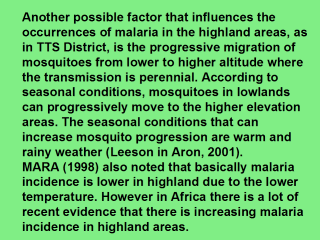 |
Marten (1995,
cited in UNEP, 1996) suggested also that at higher altitudes, an increase in
temperature of several degrees centigrade can increase the potential
transmission of malaria. The implication of this changing situation is that
there is climate and ecological change. Unfortunately the lack of reliable
malaria data made it difficult to support this argument. Aron (2001) also
stated that there is difficulty in finding clear empirical evidence of an
effect of temperature change alone on the incidence of highland malaria.
Another possible factor why malaria in highland areas can be
more prevalent than at other altitudes is presented by WHO. WHO (1979)
suggested also that the topography and altitude have to be considered as
important factors, because it determines the number of water surfaces
favorable to vector breeding sites. In Manoreh Hill, Central Java, it is
confirmed that during the dry season, the mosquitoes prefer small streambeds
and streams in the hills as breeding sites (Nalin, 2002). |
